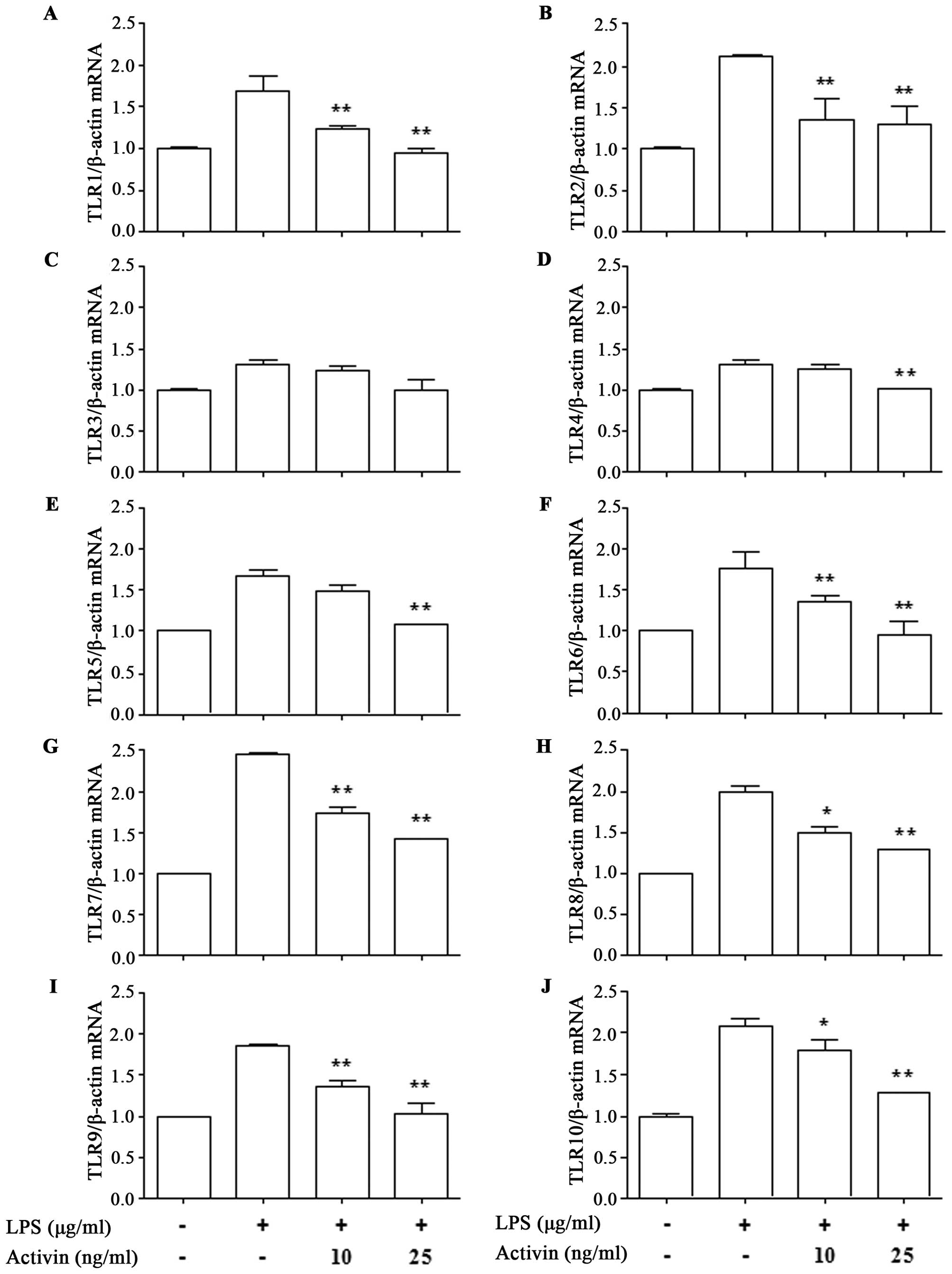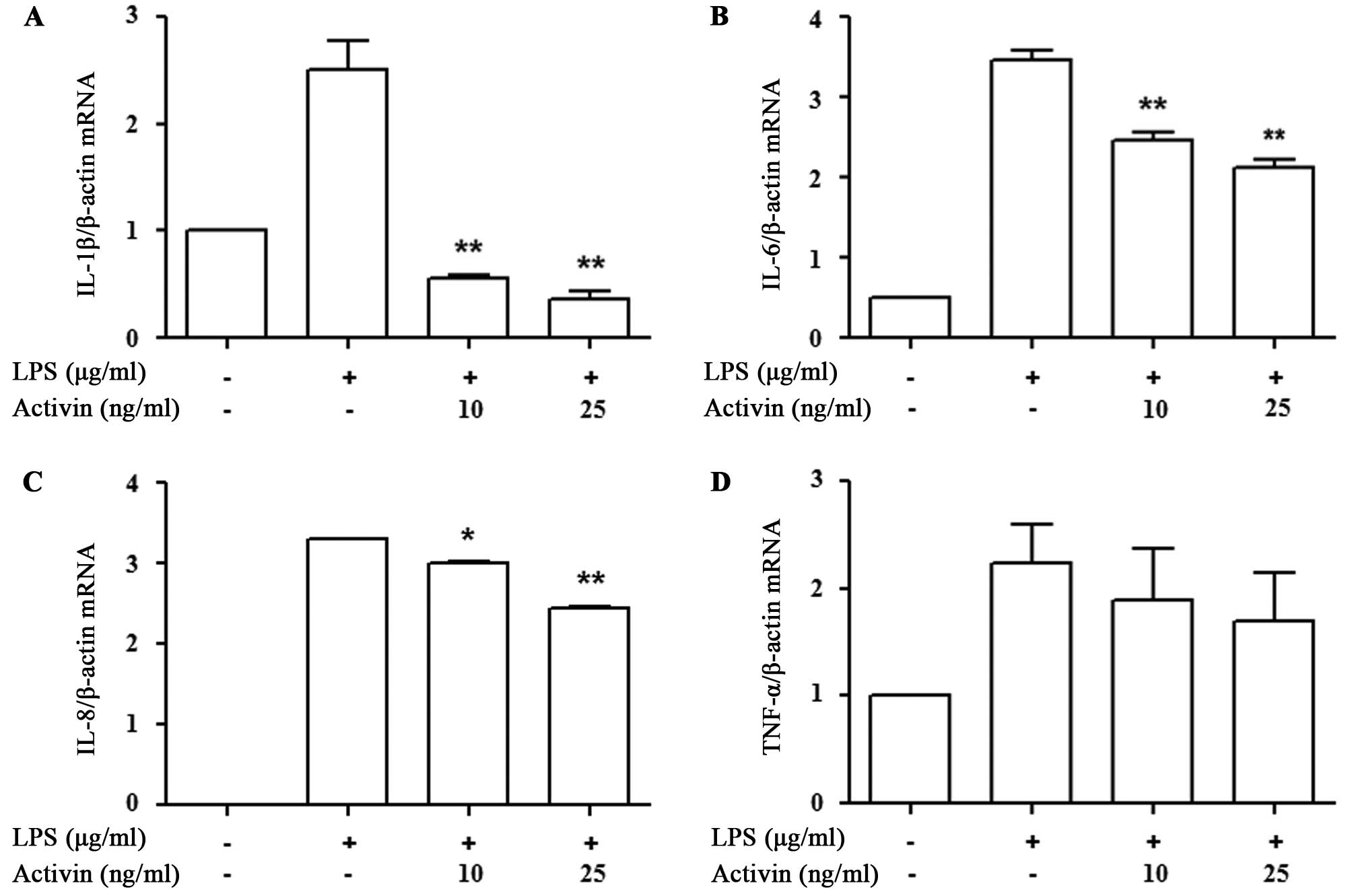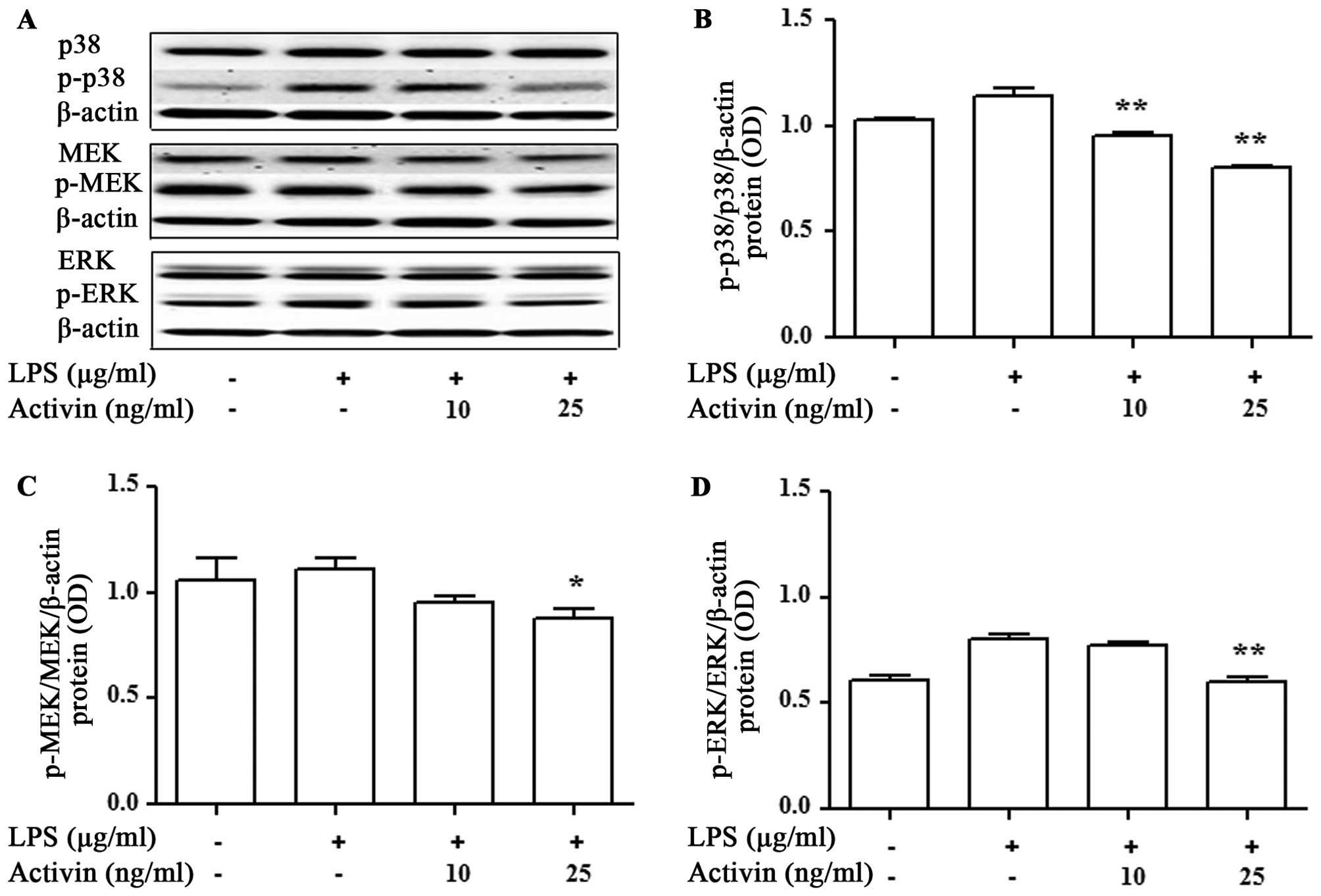|
1
|
Phillips DJ, Jones KL, Scheerlinck JY,
Hedger MP and de Kretser DM: Evidence for activin A and follistatin
involvement in the systemic inflammatory response. Mol Cell
Endocrinol. 180:155–162. 2001. View Article : Google Scholar : PubMed/NCBI
|
|
2
|
Marshak-Rothstein A and Rifkin IR:
Immunologically active autoantigens: the role of toll-like
receptors in the development of chronic inflammatory disease. Annu
Rev Immunol. 25:419–441. 2007. View Article : Google Scholar : PubMed/NCBI
|
|
3
|
Takeuchi O and Akira S: Pattern
recognition receptors and inflammation. Cell. 140:805–820. 2010.
View Article : Google Scholar : PubMed/NCBI
|
|
4
|
Akira S, Takeda K and Kaisho T: Toll-like
receptors: critical proteins linking innate and acquired immunity.
Nat Immunol. 2:675–680. 2001. View
Article : Google Scholar : PubMed/NCBI
|
|
5
|
Medzhitov R: Toll-like receptors and
innate immunity. Nat Rev Immunol. 1:135–145. 2001. View Article : Google Scholar
|
|
6
|
Barton GM and Medzhitov R: Toll-like
receptor signaling pathways. Science. 300:1524–1525. 2003.
View Article : Google Scholar : PubMed/NCBI
|
|
7
|
Kawai T and Akira S: TLR signaling. Semin
Immunol. 19:24–32. 2007. View Article : Google Scholar : PubMed/NCBI
|
|
8
|
Lee YM, Seon MR, Cho HJ, Kim JS and Park
JH: Benzyl isothiocyanate exhibits anti-inflammatory effects in
murine macrophages and in mouse skin. J Mol Med Berl. 87:1251–1261.
2009. View Article : Google Scholar : PubMed/NCBI
|
|
9
|
Zaidi SF, Yamamoto T, Refaat A, Ahmed K,
Sakurai H, Saiki I, Kondo T, Usmanghani K, Kadowaki M and Sugiyama
T: Modulation of activation-induced cytidine deaminase by curcumin
in Helicobacter pylori-infected gastric epithelial cells.
Helicobacter. 14:588–595. 2009. View Article : Google Scholar : PubMed/NCBI
|
|
10
|
Marletta MA: Approaches toward selective
inhibition of nitric oxide synthase. J Med Chem. 37:1899–1907.
1994. View Article : Google Scholar : PubMed/NCBI
|
|
11
|
Nathan C and Xie QW: Nitric oxide
synthases: Roles, tolls, and controls. Cell. 78:915–918. 1994.
View Article : Google Scholar : PubMed/NCBI
|
|
12
|
Mathews LS: Activin receptors and cellular
signaling by the receptor serine kinase family. Endocr Rev.
15:310–325. 1994. View Article : Google Scholar : PubMed/NCBI
|
|
13
|
Mather JP, Moore A and Li RH: Activins,
inhibins, and follistatins: further thoughts on a growing family of
regulators. Proc Soc Exp Biol Med. 215:209–222. 1997. View Article : Google Scholar : PubMed/NCBI
|
|
14
|
Sugama S, Takenouchi T, Kitani H, Fujita M
and Hashimoto M: Activin as an anti-inflammatory cytokine produced
by microglia. J Neuroimmunol. 192:31–39. 2007. View Article : Google Scholar : PubMed/NCBI
|
|
15
|
Wang SY, Tai GX, Zhang PY, Mu DP, Zhang XJ
and Liu ZH: Inhibitory effect of activin A on activation of
lipopolysaccharide-stimulated mouse macrophage RAW264.7 cells.
Cytokine. 42:85–91. 2008. View Article : Google Scholar : PubMed/NCBI
|
|
16
|
Plonka PM, Passeron T, Brenner M, Tobin
DJ, Shibahara S, Thomas A, Slominski A, Kadekaro AL, Hershkovitz D,
Peters E, et al: What are melanocytes really doing all day long?
Exp Dermatol. 18:799–819. 2009. View Article : Google Scholar : PubMed/NCBI
|
|
17
|
Tsatmali M, Ancans J and Thody AJ:
Melanocyte function and its control by melanocortin peptides. J
Histochem Cytochem. 50:125–133. 2002. View Article : Google Scholar : PubMed/NCBI
|
|
18
|
Mattei S, Colombo MP, Melani C, Silvani A,
Parmiani G and Herlyn M: Expression of cytokine/growth factors and
their receptors in human melanoma and melanocytes. Int J Cancer.
56:853–857. 1994. View Article : Google Scholar : PubMed/NCBI
|
|
19
|
Ahn JH, Park TJ, Jin SH and Kang HY: Human
melanocytes express functional Toll-like receptor 4. Exp Dermatol.
17:412–417. 2008. View Article : Google Scholar : PubMed/NCBI
|
|
20
|
Stove C, Vanrobaeys F, Devreese B, Van
Beeumen J, Mareel M and Bracke M: Melanoma cells secrete
follistatin, an antagonist of activin-mediated growth inhibition.
Oncogene. 23:5330–5339. 2004. View Article : Google Scholar : PubMed/NCBI
|
|
21
|
Sabroe I, Read RC, Whyte MK, Dockrell DH,
Vogel SN and Dower SK: Toll-like receptors in health and disease:
complex questions remain. J Immunol. 171:1630–1635. 2003.
View Article : Google Scholar : PubMed/NCBI
|
|
22
|
Cook DN, Pisetsky DS and Schwartz DA:
Toll-like receptors in the pathogenesis of human disease. Nat
Immunol. 5:975–979. 2004. View
Article : Google Scholar : PubMed/NCBI
|
|
23
|
Strober W, Murray PJ, Kitani A and
Watanabe T: Signalling pathways and molecular interactions of NOD1
and NOD2. Nat Rev Immunol. 6:9–20. 2006. View Article : Google Scholar : PubMed/NCBI
|
|
24
|
Yu N, Zhang S, Zuo F, Kang K, Guan M and
Xiang L: Cultured human melanocytes express functional toll-like
receptors 2–4, 7 and 9. J Dermatol Sci. 56:113–120. 2009.
View Article : Google Scholar : PubMed/NCBI
|
|
25
|
Jin SH and Kang HY: Activation of
toll-like receptors 1, 2, 4, 5, and 7 on human melanocytes modulate
pigmentation. Ann Dermatol. 22:486–489. 2010. View Article : Google Scholar : PubMed/NCBI
|
|
26
|
Tsatmali M, Graham A, Szatkowski D, Ancans
J, Manning P, McNeil CJ, Graham AM and Thody AJ:
alpha-melanocyte-stimulating hormone modulates nitric oxide
production in melanocytes. J Invest Dermatol. 114:520–526. 2000.
View Article : Google Scholar : PubMed/NCBI
|
|
27
|
Wang R, Ghahary A, Shen YJ, Scott PG and
Tredget EE: Human dermal fibroblasts produce nitric oxide and
express both constitutive and inducible nitric oxide synthase
isoforms. J Invest Dermatol. 106:419–427. 1996. View Article : Google Scholar : PubMed/NCBI
|
|
28
|
Rocha IM and Guillo LA: Lipopolysaccharide
and cytokines induce nitric oxide synthase and produce nitric oxide
in cultured normal human melanocytes. Arch Dermatol Res.
293:245–248. 2001. View Article : Google Scholar : PubMed/NCBI
|
|
29
|
Gupta SC, Sundaram C, Reuter S and
Aggarwal BB: Inhibiting NF-κB activation by small molecules as a
therapeutic strategy. Biochim Biophys Acta. 1799:775–787. 2010.
View Article : Google Scholar : PubMed/NCBI
|
|
30
|
Wan F and Lenardo MJ: The nuclear
signaling of NF-kappaB: current knowledge, new insights, and future
perspectives. Cell Res. 20:24–33. 2010. View Article : Google Scholar
|
|
31
|
Kaminska B: MAPK signalling pathways as
molecular targets for anti-inflammatory therapy - from molecular
mechanisms to therapeutic benefits. Biochim Biophys Acta.
1754:253–262. 2005. View Article : Google Scholar : PubMed/NCBI
|
|
32
|
Yamashita N, Nakajima T, Takahashi H,
Kaneoka H, Mizushima Y and Sakane T: Effects of activin A on IgE
synthesis and cytokine production by human peripheral mononuclear
cells. Clin Exp Immunol. 94:214–219. 1993. View Article : Google Scholar : PubMed/NCBI
|
|
33
|
Murase Y, Okahashi N, Koseki T, Itoh K,
Udagawa N, Hashimoto O, Sugino H, Noguchi T and Nishihara T:
Possible involvement of protein kinases and Smad2 signaling
pathways on osteoclast differentiation enhanced by activin A. J
Cell Physiol. 188:236–242. 2001. View
Article : Google Scholar : PubMed/NCBI
|
|
34
|
Sugatani T, Alvarez UM and Hruska KA:
Activin A stimulates IkappaB-alpha/NFkappaB and RANK expression for
osteoclast differentiation, but not AKT survival pathway in
osteoclast precursors. J Cell Biochem. 90:59–67. 2003. View Article : Google Scholar : PubMed/NCBI
|















